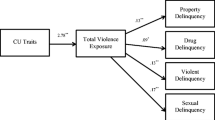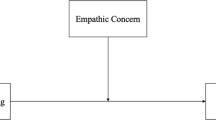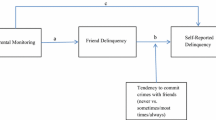Abstract
Objectives
Adolescent delinquency is an important issue, and of universal concern. Parental arrest history has been recognized to have negative impacts on children’s delinquent behavior. This study focused on the predictors of adolescent delinquency, including parental influences and adolescents’ own personal traits.
Methods
We explored the relationship between parental arrest and children’s delinquency among 1027 Singaporean secondary school students aged between 12 and 19 years (Mage = 14.10). Specifically, we used hierarchical multiple regression to examine the moderating effects that different dimensions of psychopathic traits, including narcissism, callous-unemotional (CU) traits, and impulsivity, have on the relation between parental arrest and adolescent delinquency.
Results
Findings suggested that parental arrest significantly and positively predicted the delinquent behavior of their children. Although narcissism, CU traits, and impulsivity showed significant main effects on delinquency, only narcissism and CU traits, but not impulsivity, were found to significantly interact with parental arrest in predicting adolescent delinquency. With a high level of narcissism and CU traits, adolescents whose parents have had a prior arrest history were more likely to display higher levels of delinquent behavior.
Conclusions
These findings shed light on the importance of reducing adolescents’ narcissism and CU traits when developing prevention and intervention strategies to combat delinquency of adolescents with arrested parents in an Asian context.


Similar content being viewed by others
References
Aiken, L. S., & West, S. G. (1991). Multiple regression: Testing and interpreting interactions. Newbury Park: Sage.
Babinski, L. M., Hartsough, C. S., & Lambert, N. M. (1999). Childhood conduct problems, hyperactivity-impulsivity, and inattention as predictors of adult criminal activity. Journal of Child Psychology and Psychiatry, 40, 347–355.
Barry, C. T., Grafeman, S. J., Adler, K. K., & Pickard, J. D. (2007). The relations among narcissism, self-esteem, and delinquency in a sample of at-risk adolescents. Journal of Adolescence, 30, 933–942.
Bezdjian, S., Raine, A., Baker, L. A., & Lynam, D. R. (2011). Psychopathic personality in children: genetic and environmental contributions. Psychological Medicine, 41, 589–600.
Bush, N. R., Lengua, L. J., & Colder, C. R. (2010). Temperament as a moderator of the relation between neighborhood and children’s adjustment. Journal of Applied Developmental Psychology, 31, 351–361.
Bushman, B. J., & Baumeister, R. F. (2002). Does self-love or self-hate lead to violence? Journal of Research in Personality, 36, 543–545.
Carroll, A., Hemingway, F., Bower, J., Ashman, A., Houghton, S., & Durkin, K. (2006). Impulsivity in juvenile delinquency: differences among early-onset, late-onset, and non-offenders. Journal of Youth and Adolescence, 35, 517–527.
Chng, G. S., Chu, C. M., Zeng, G., Li, D., & Ting, M. H. (2016). A latent class analysis of family characteristics linked to youth offending outcomes. Journal of Research in Crimean and Delinquency, 56, 765–787.
DeLisi, M., & Vaughn, M. G. (2015). Ingredients for criminality require genes, temperament, and psychopathic personality. Journal of Criminal Justice, 43, 290–294.
Dong, B., & Krohn, M. D. (2015). Exploring intergenerational discontinuity in problem behavior: bad parents with good children. Youth Violence and Juvenile Justice, 13, 99–122.
Elliott, D. S., Huizinga, D., & Ageton, S. S. (1985). Explaining delinquency and drug use. CA: Sage Publications.
Fanti, K. A., & Henrich, C. C. (2015). Effects of self-esteem and narcissism on bullying and victimization during early adolescence. The Journal of Early Adolescence, 35, 5–29.
Farrington, D. P., Jolliffe, D., Loeber, R., Stouthamer-Loeber, M., & Kalb, L. M. (2001). The concentration of offenders in families, and family criminality in the prediction of boys’ delinquency. Journal of Adolescence, 24, 579–596.
Fontaine, N. M., McCrory, E. J., Boivin, M., Moffitt, T. E., & Viding, E. (2011). Predictors and outcomes of joint trajectories of callous-unemotional traits and conduct problems in childhood. Journal of Abnormal Psychology, 120, 730–742.
Frick, P. J., Bodin, S. D., & Barry, C. T. (2000). Psychopathic traits and conduct problems in community and clinic-referred samples of children: further development of the Psychopathy Screening Device. Psychological Assessment, 12, 382–393.
Frick, P. J., Cornell, A. H., Bodin, S. D., Dane, H. E., Barry, C. T., & Loney, B. R. (2003). Callous-unemotional traits and developmental pathways to severe conduct problems. Developmental Psychology, 39, 246–260.
Jolliffe, D., & Farrington, D. P. (2004). Empathy and offending: a systematic review and meta-analysis. Aggression and Violent Behavior, 9, 441–476.
Kinner, S. A., Alati, R., Najman, J. M., & Williams, G. M. (2007). Do paternal arrest and imprisonment lead to child behaviour problems and substance use? A longitudinal analysis. Journal of Child Psychology and Psychiatry, 48, 1148–1156.
Kroneman, L. M., Hipwell, A. E., Loeber, R., Koot, H. M., & Pardini, D. A. (2011). Contextual risk factors as predictors of disruptive behavior disorder trajectories in girls: the moderating effect of callous‐unemotional features. Journal of Child Psychology and Psychiatry, 52, 167–175.
Leith, K. P., & Baumeister, R. F. (1996). Why do bad moods increase self-defeating behavior? Emotion, risk tasking, and self-regulation. Journal of Personality and Social Psychology, 71, 1250–1267.
Li, X., Chan, W. T., Ang, R. P., & Huan, V. S. (2017). Assessment of psychopathic traits in Singaporean adolescents: validation of the Antisocial Process Screening Device (APSD). Journal of psychopathology and Behavioral Assessment, 39, 198–208.
Marsee, M. A., Silverthorn, P., & Frick, P. J. (2005). The association of psychopathic traits with aggression and delinquency in non-referred boys and girls. Behavioral Sciences and the Law, 23, 803–817.
Muñoz, L. C., & Frick, P. J. (2007). The reliability, stability, and predictive utility of the self-report version of the Antisocial Process Screening Device. Scandinavian Journal of Psychology, 48, 299–312.
Muñoz, L. C., Kimonis, E. R., Frick, P. J., & Aucoin, K. J. (2013). Emotional reactivity and the association between psychopathy-linked narcissism and aggression in detained adolescent boys. Development and Psychopathology, 25, 473–485.
Nijhof, K. S., de Kemp, R. A., & Engels, R. C. (2009). Frequency and seriousness of parental offending and their impact on juvenile offending. Journal of Adolescence, 32, 893–908.
Ometto, M., de Oliveira, P. A., Milioni, A. L., Dos Santos, B., Scivoletto, S., & Busatto, G. F., et al. (2016). Social skills and psychopathic traits in maltreated adolescents. European Child & Adolescent Psychiatry, 25, 397–405.
Oxford, M., Cavell, T. A., & Hughes, J. N. (2003). Callous/unemotional traits moderate the relation between ineffective parenting and child externalizing problems: a partial replication and extension. Journal of Clinical Child and Adolescent Psychology, 32, 577–585.
Pardini, D. A., Lochman, J. E., & Frick, P. J. (2003). Callous/unemotional traits and social-cognitive processes in adjudicated youths. Journal of the American Academy of Child & Adolescent Psychiatry, 42, 364–371.
Rioux, C., Castellanos-Ryan, N., Parent, S., Vitaro, F., Tremblay, R. E., & Séguin, J. R. (2016). Differential susceptibility to environmental influences: Interactions between child temperament and parenting in adolescent alcohol use. Development and Psychopathology, 28, 265–275.
Roberts, Y. H., Snyder, F. J., Kaufman, J. S., Finley, M. K., Griffin, A., & Anderson, J., et al. (2014). Children exposed to the arrest of a family member: associations with mental health. Journal of Child and family Studies, 23, 214–224.
Seals, R. W., Sharp, C., Ha, C., & Michonski, J. D. (2012). The relationship between the Youth Psychopathic Traits Inventory and psychopathology in a US community sample of male youth. Journal of Personality Assessment, 94, 232–243.
Skeem, J. L., Scott, E. S., & Mulvey, E. P. (2014). Justice policy reform for high-risk juveniles: using science to achieve large-scale crime reduction. Annual Review of Clinical Psychology, 10, 709–739.
Snyder, J., Prichard, J., Schrepferman, L., Patrick, M. R., & Stoolmiller, M. (2004). Child impulsiveness—inattention, early peer experiences, and the development of early onset conduct problems. Journal of Abnormal Child Psychology, 32, 579–594.
Stice, E., & Gonzales, N. (1998). Adolescent temperament moderates the relation of parenting to antisocial behavior and substance use. Journal of Adolescent Research, 13, 5–31.
Thomaes, S., Bushman, B. J., Orobio de Castro, B., & Stegge, H. (2009). What makes narcissists bloom? A framework for research on the etiology and development of narcissism. Development and Psychopathology, 21, 1233–1247.
Vitulano, M. L., Fite, P. J., & Rathert, J. L. (2010). Delinquent peer influence on childhood delinquency: the moderating effect of impulsivity. Journal of psychopathology and Behavioral Assessment, 32, 315–322.
Waller, R., Gardner, F., & Hyde, L. W. (2013). What are the associations between parenting, callous-unemotional traits, and antisocial behavior in youth? A systematic review of evidence. Clinical Psychology Review, 33, 593–608.
Yau, T. C. Y., & Chung, H. Y. (2014). Children with an imprisoned parent: children’s and caregivers’ narratives. China Journal of Social Work, 7, 92–112.
Acknowledgements
This research was supported by the Ministry of Education (Singapore) AcRF Tier 2 Grant (MOE2012-T2-1-079).
Author information
Authors and Affiliations
Corresponding author
Ethics declarations
Conflict of Interest
The authors declare that they have no conflict of interest.
Ethical Approval
This study was approved by the Institutional Review Board at Nanyang Technological University. The Ministry of Education of Singapore and the school principals also approved the data collection at the schools.
Informed Consent
Informed consent was obtained from all individual participants included in the study.
Additional information
Publisher’s note: Springer Nature remains neutral with regard to jurisdictional claims in published maps and institutional affiliations.
Rights and permissions
About this article
Cite this article
Li, X., Ang, R.P. Parental Arrest and Adolescent Delinquency in Singapore: The Moderating Roles of Narcissism, Callous-Unemotional Traits, and Impulsivity. J Child Fam Stud 28, 776–783 (2019). https://doi.org/10.1007/s10826-018-01311-6
Published:
Issue Date:
DOI: https://doi.org/10.1007/s10826-018-01311-6




